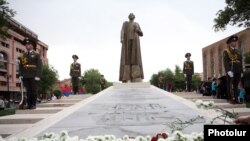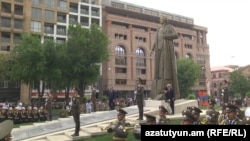Russia criticized Armenia on Friday for erecting a statue in Yerevan of an Armenian nationalist statesman who fought against the Bolsheviks and later collaborated with Nazi Germany.
A Russian Foreign Ministry spokesperson said Garegin Nzhdeh’s statue is “not compatible with the memory of heroes” of World War II, among them many Armenians. The ruling Republican Party of Armenia dismissed the criticism.
Born in the Russian Empire in 1886, Nzhdeh became an Armenian nationalist militant at a young age and spent several years in Russian prisons as a result. He was pardoned by the Russian authorities before commanding one of the Armenian volunteer units that fought the Ottoman Turkish army alongside Russian troops during World War War I.
Nzhdeh went on to become one of the prominent military leaders of an independent Armenian republic formed in 1918 following the Bolshevik revolution. In late 1920, he mounted armed resistance against the republic’s takeover by Bolshevik Russia in Zangezur, a mountainous region in what is now southeastern Armenia. Nzhdeh and his supporters ended the resistance and fled to neighboring Persia in July 1921 after receiving assurances that the region will not be incorporated into Soviet Azerbaijan.
Nzhdeh was one of several exiled Armenian leaders who pledged allegiance to Nazi Germany in 1942 with the stated aim of saving Soviet Armenia from a possible Turkish invasion after what they expected to be a Soviet defeat by the Third Reich. Their “Armenian national council” cobbled together several battalions mainly comprising Armenian prisoners of war from the Red Army. The so-called Armenian Legion never played a major role in the Wehrmacht’s military operations, however.
Nzhdeh surrendered to advancing Red Army divisions in Bulgaria in 1944 after reportedly offering Josef Stalin to mobilize Armenians for a Soviet assault on Turkey. In 1948, a Soviet court sentenced him to 25 years in prison on charges that mainly stemmed from his “counterrevolutionary” activities in 1920-1921, rather than collaboration with Nazi Germany. He died in a Soviet prison in 1955.
Nzhdeh was rehabilitated in Armenia after the republic’s last Communist government was removed from power in 1990. The first post-Communist Armenian government named a square and metro station in Yerevan after him in the following years.
Nzhdeh is widely credited with preserving Armenian control over Zangezur, a strategic region bordering Iran. He is also revered by many in the country as the founder of a new brand of Armenian nationalism that emerged in the 1930s.
His Tseghakron ideology put the emphasis on armed self-defense, military organization and self-reliance. The ruling Republican Party of Armenia (HHK) has espoused it throughout its existence.
The HHK, which is headed by President Serzh Sarkisian, was instrumental in the Yerevan municipality’s decision to place Nzhdeh’s statue in the city center. The statue was unveiled on May 28 in the presence of Sarkisian and other senior officials.
“We cannot understand why that statue was placed,” Maria Zakharova, the Russian Foreign Minstry spokeswoman, told a news briefing in Moscow.
Zakharova said that the Russian government is strongly opposed to “any revival, glorification or other manifestations of Nazism, neo-Nazism and extremism.” She also pointed to the “immortal feat of the Armenian people” during World War II.
Hundreds of thousands of Armenians were drafted to the Red Army and nearly half of them died during the war. The most famous of them, notably Marshal Ivan Bagramian and Admiral Ivan Isakov, still have streets in Armenia bearing their names and are regularly honored by the Armenian authorities.
Just five days before the erection of Nzdeh’s statue, the authorities unveiled a statue of another Soviet Armenian marshal, Hamazasp Babajanian, in the Armenian the capital. Sarkisian attended that ceremony as well.
While criticizing Nzhdeh’s statue, Zakharova stressed that May 9, which marks the anniversary of the Soviet defeat of Nazi Germany, remains a public holiday in Armenia. This is “the main indicator of official Yerevan’s position on preserving the historical truth about the Great Patriotic War,” she said.
The Armenian ruling party was quick to reject the Russian criticism. “Garegin Nzhdeh is one of the greatest heroes of the Armenian nation,” HHK spokesman Eduard Sharmazanov told 168.am. He said Nzhdeh’s activities were always aimed at “the liberation, salvation and independence of the Armenian people.”
Sharmazanov also downplayed the nationalist leader’s links with the Wehrmacht. He said the Soviet Union itself signed a nonaggression pact with Nazi Germany in 1939.





